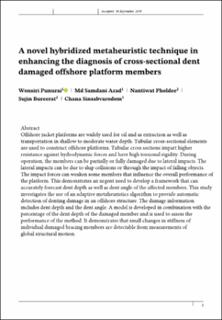A novel hybridized metaheuristic technique in enhancing the diagnosis of cross-sectional dent damaged offshore platform members
Peer reviewed, Journal article
Accepted version

Åpne
Permanent lenke
https://hdl.handle.net/11250/2649829Utgivelsesdato
2019Metadata
Vis full innførselSamlinger
- Institutt for marin teknikk [3472]
- Publikasjoner fra CRIStin - NTNU [38576]
Sammendrag
Offshore jacket platforms are widely used for oil and gas extraction as well as transportation in shallow to moderate water depth. Tubular cross‐sectional elements are used to construct offshore platforms. Tubular cross sections impart higher resistance against hydrodynamic forces and have high torsional rigidity. During operation, the members can be partially or fully damaged due to lateral impacts. The lateral impacts can be due to ship collisions or through the impact of falling objects. The impact forces can weaken some members that influence the overall performance of the platform. This demonstrates an urgent need to develop a framework that can accurately forecast dent depth as well as dent angle of the affected members. This study investigates the use of an adaptive metaheuristics algorithm to provide automatic detection of denting damage in an offshore structure. The damage information includes dent depth and the dent angle. A model is developed in combination with the percentage of the dent depth of the damaged member and is used to assess the performance of the method. It demonstrates that small changes in stiffness of individual damaged bracing members are detectable from measurements of global structural motion.